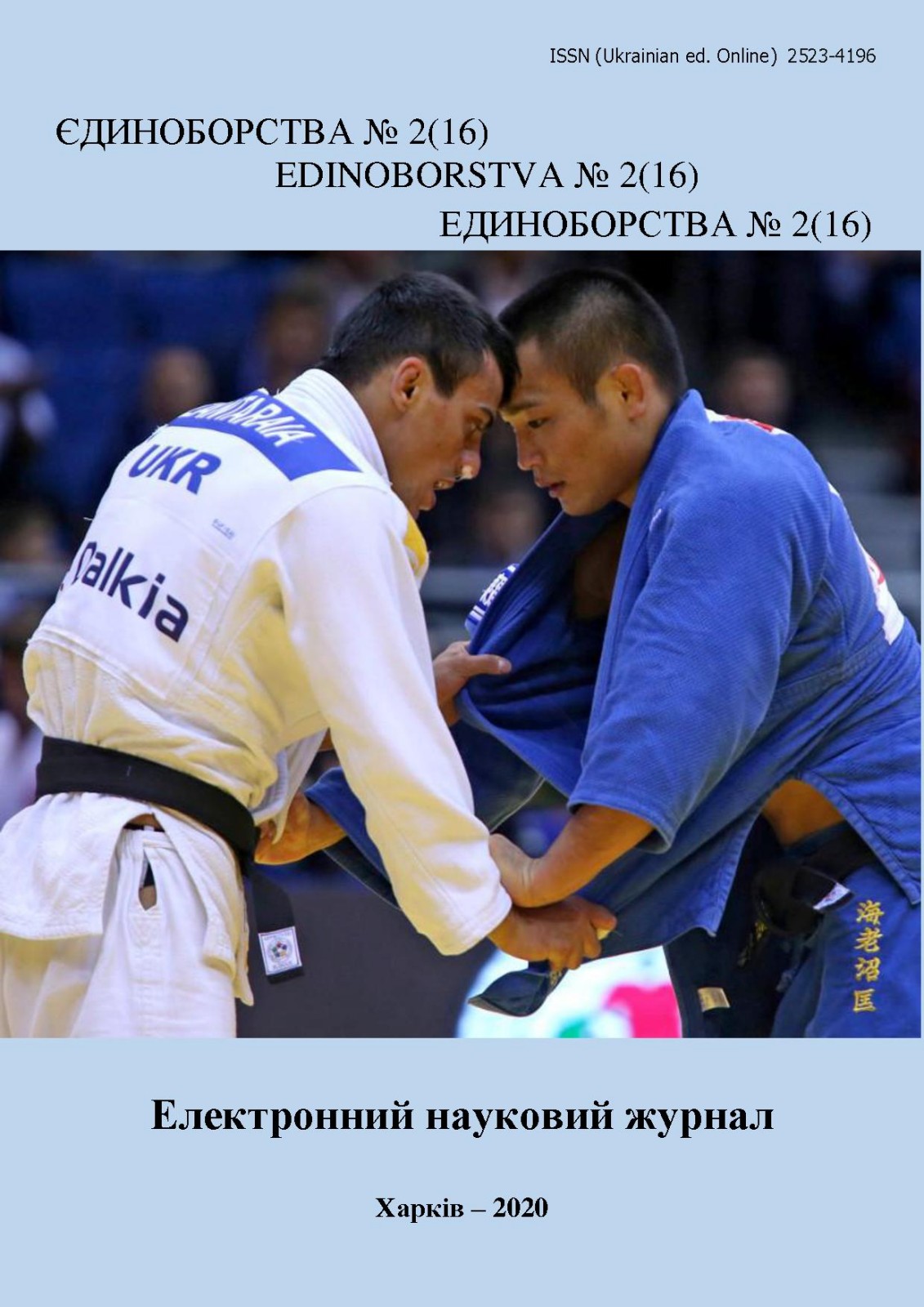Comparative analysis of the physical fitness of first-year students of the HGAFK specialization in «cross-country skiing» and «martial arts»
DOI:
https://doi.org/10.15391/ed.2020-2.06Keywords:
physical fitness, results, students, skiing, martial arts, testsAbstract
Purpose: to conduct a comparative analysis of the physical fitness of first-year students of the HGAFK of sports specializations in «cross-country skiing» and «martial arts». Material and methods. The study involved 26 young athletes. Including 17 athletes who are engaged in martial arts. Of these, 7 are candidates for master of sports and 10 first-class athletes. Of the 9 athletes of cross-country skiers, 6 first-class athletes and 3 candidates for master of sports took part in the study. Pedagogical research was conducted on the basis of the Kharkov State Academy of Physical Culture. Assessment of the development of motor abilities of students was carried out according to 7 test tasks of the basic physical qualities (speed, endurance, strength, flexibility and dexterity). During the study, the following methods were used: theoretical analysis and generalization of scientific and methodological literature, pedagogical research, pedagogical observation, pedagogical testing, methods of mathematical statistics. Results. Speed test results have shown that students in the specialty «ski racing» have 4.3 points, which is high. Oriental Martial Arts students have 4,0 points, which is good. High endurance levels were found in the ski race specialization (4,5 points). The average level of preparedness in the students of the specialization is oriental «martial arts» (4,2 points). The average results of arm strength with the help of pull-ups on the crossbar in the specialization oriental «martial arts» - 4,2 points, in students of the specialization «ski racing» - 4,0 points. When testing the strength of the abdominal muscles, it was found that the students of the Oriental «martial arts» specialty have the best performance – 51,06 times, and the average of the athletes of the «ski racing» specialization is 45,23 times. The best results in the long jump from the place were found in the students of the specialty oriental «martial arts» - 253,2 cm. Students of the specialization «ski race» showed results - 246,0 cm, which correspond to four points. High rates of flexibility in the hip joints were obtained from the students of the specialty oriental «martial arts» - 18,96 cm. Students of the specialty «ski race» showed the results of about four points. The best students in the Oriental «martial arts» specialization were 4,2 points. Students in the specialty «ski racing» showed the results of about 4 points. There were no significant differences between the «ski races2 and oriental «martial arts» specializations (p>0,05). Conclusions. Test results of students 'physical readiness testify that students' level of physical fitness is not the same, but most surveyed students have an average level of physical fitness according to the state system of physical fitness tests of the population of Ukraine, provided for their age and gender. The analysis of the results of the research shows that students of the specialty «ski racing» are dominated by such physical qualities as endurance and speed, and students of the specialization oriental «martial arts» - flexibility, strength and agility.
References
Арансон, М. В., Озолин, Э. С., & Шустин, Б. Н. (2015). Тенденции научных исследований в видах единоборств. Вестник спортивной науки, (3), 4-9.
Бойченко, Н. В. (2017). Оздоровчий вплив засобів східних єдиноборств на організм студенток ВНЗ. Єдиноборства, 26-30.
Бойченко, Н. В., Станкевич, Б., & Дрозд, М. С. (2014). Контроль за станом підготовленості борця. Проблемы и перспективы развития спортивных игр и единоборств в высших учебных заведениях, 1, 14-17.
Горіна В. В., & Сидорова Т. В. (2019). Дослідження рівня фізичних якостей велосипедистів 14-15 років під впливом фізичних навантажень у підготовчому періоді. Збірник наукових праць Харківської державної академії фізичної культури. Основи побудови тренувального процесу в циклічних та екстремальних видах спорту, 22-26.
Гостіщев В. М. (2010). Рівень фізичної підготовленності як чинник мотивації студентів до фізичної активності в умовах навчального процесу та у вільний час. Слобожанський науково-спортивний вісник, 1, 15-17.
Григорьев, В. И., Шубин, Ю. К., Панченко, И. А., & Зиновьев, Н. А. (2014). Управление физической подготовкой студентов на основе применения балльно-рейтингового контроля. Теория и практика физической культуры, (6), 10-12.
Камаев, О. И. (2000). Теоретические и методические основы оптимизации системы многолетней подготовки юных лыжников-гонщиков. (Автореф. дисс. д-ра наук по физ. восп). Харьков, Украина.
Конюх, А. П. & Маликов, Н. В. (2003). Изучение физической подготовленности студенток высших учебных заведений в динамике года. Педагогика, психологія та медико-біологічні проблеми фізичної культури і спорту, №7, 64 – 71.
Платонов, В. Н. (2015). Система подготовки спортсменов в олимпийском спорте. Общая теория и ее практические приложения : учебник [для тренеров] : 2 кн. Олимп. лит., Киев.
Пруднікова, М. С., & Горіна, В. В. (2011). Уровень физической подготовленности студентов второго курса кафедры зимних видов спорта, велоспорта и туризма. Слобожанський науково-спортивний вісник, 4, 23-30.
Сергієнко, В. М. (2004). Рівень фізичної підготовленості студентів факультету фізичної культури. Науковий вісник Волининського держ.ун-ту ім. Лесі Українки, №4,199 202.
Сидорова, Т. В. & Котляр, С. М. (2017). Особливості фізичної підготовленості студентів різних спортивних спеціалізацій. Збірник наукових праць Харківської державної академії фізичної культури. Удосконалення тренувального процесу в зимових видах спорту (в тому числі і спортсменів з обмеженими можливостями), 40-49.













